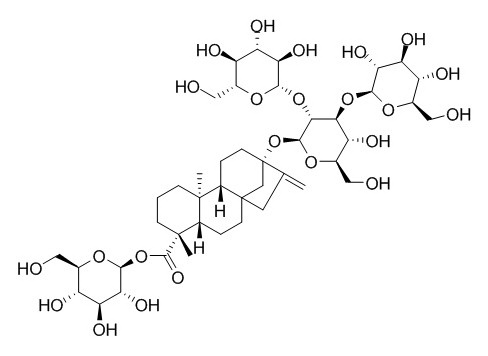Rebaudioside A
Rebaudioside A, an natural sweetening ingredient, is approximately 250 to 300 times sweeter than sucrose, do not contribute calories or carbohydrates to the diet and do not affect blood glucose or insulin response. It is a α-glucosidase inhibitor with IC50 of 35.01 μg/ml.
Inquire / Order:
manager@chemfaces.com
Technical Inquiries:
service@chemfaces.com
Tel:
+86-27-84237783
Fax:
+86-27-84254680
Address:
1 Building, No. 83, CheCheng Rd., Wuhan Economic and Technological Development Zone, Wuhan, Hubei 430056, PRC
Providing storage is as stated on the product vial and the vial is kept tightly sealed, the product can be stored for up to
24 months(2-8C).
Wherever possible, you should prepare and use solutions on the same day. However, if you need to make up stock solutions in advance, we recommend that you store the solution as aliquots in tightly sealed vials at -20C. Generally, these will be useable for up to two weeks. Before use, and prior to opening the vial we recommend that you allow your product to equilibrate to room temperature for at least 1 hour.
Need more advice on solubility, usage and handling? Please email to: service@chemfaces.com
The packaging of the product may have turned upside down during transportation, resulting in the natural compounds adhering to the neck or cap of the vial. take the vial out of its packaging and gently shake to let the compounds fall to the bottom of the vial. for liquid products, centrifuge at 200-500 RPM to gather the liquid at the bottom of the vial. try to avoid loss or contamination during handling.
Oxid Med Cell Longev.2022, 2022:5888636.
Sains Malaysiana2024, 53(4):795-805
Journal of Food Hygiene and Safety2019, 34(5):413-420
Molecules.2024, 29(23):5632.
Journal of Functional Foods2017, 30:30-38
Appl. Sci. 2021, 11(10),4666.
Thorac Cancer.2023, 14(21):2007-2017.
Molecules.2023, 28(7):3039.
Genes (Basel).2021, 12(7):1024.
Cells.2022, 11(8), 1311.
Related and Featured Products
Food Chem Toxicol. 2014 Apr;66:334-40.
The non-cytotoxicity characterization of rebaudioside A as a food additive.[Pubmed:
24500608]
To evaluate the cytotoxicity of high-purity Rebaudioside A (reb A, 99.16%) as a food ingredient, a combination of several methods, including tetrazolium-based colorimetric assay (MTT), lactate dehydrogenase assay (LDH), enzyme-linked immunosorbent assay (ELISA), real-time PCR (qPCR), high-performance liquid chromatography (HPLC), and two-dimensional electrophoresis (2-DE) were used to test the cytotoxicity of Rebaudioside A on the human cells HT-29 and T84, as well as liver and spleen cells from mice. The results indicated that no obvious changes in cellular viability, inflammatory cytokines yield, or protein yield were observed between the test group and the control group when different concentrations of Rebaudioside A were used, suggesting that Rebaudioside A is non-cytotoxic in vitro at the concentrations range tested (0.001-0.5%).
Food Chem . 2016 Jun 1;200:154-8.
Synthesis of rebaudioside-A by enzymatic transglycosylation of stevioside present in the leaves of Stevia rebaudiana Bertoni[Pubmed:
26830573]
Abstract
Rebaudioside-A is the second most abundant sweet diterpene glycoside (1-3%) present in the leaves of Stevia rebaudiana Bertoni, and is now being considered as a possible sucrose substitute due to its pleasant organoleptic properties and associated health benefits. In the present study, a novel in situ enzymatic transglycosylation of stevioside has been developed by pre-treating the stevia leaves with cellulase and adding soluble starch as the glucosyl donor. The results confirm that the transglycosylation of stevioside led to an enrichment in the rebaudioside-A content from 4% to 66%. This was further purified by multiple column chromatography to obtain 95% pure rebaudioside-A. The isolated rebaudioside-A showed concentration-dependent α-glucosidase inhibitory activity with IC50=35.01 μg/ml. Thus the study highlights the biotransformation of stevioside present in stevia leaves to rebaudioside-A by a simple, inexpensive and eco-friendly process that has commercial potential.
Keywords: Cellulase; Glucosyl donors; Rebaudioside-A; Rebaudioside-A (PubChem CID:6918840); Stevia leaves; Stevioside (PubChem CID:442089); Transglycosylation.
Molecules. 2014 Oct 28;19(11):17345-55.
Bioconversion of rebaudioside I from rebaudioside A.[Pubmed:
25353385]
To supply the increasing demand of natural high potency sweeteners to reduce the calories in food and beverages, we have looked to steviol glycosides. In this work we report the bioconversion of Rebaudioside A to rebaudioside I using a glucosyltransferase enzyme. This bioconversion reaction adds one sugar unit with a 1→3 linkage. We utilized 1D and 2D NMR spectroscopy (1H, 13C, COSY, HSQC-DEPT, HMBC, 1D TOCSY and NOESY) and mass spectral data to fully characterize rebaudioside I.
Carbohydr Res. 2009 Dec 14;344(18):2533-8.
NMR studies of the conformation of the natural sweetener rebaudioside A.[Pubmed:
19889398]
Rebaudioside A is a natural sweetener from Stevia rebaudiana in which four beta-D-glucopyranose units are attached to the aglycone steviol. Its (1)H and (13)C NMR spectra in pyridine-d(5) were assigned using 1D and 2D methods. Constrained molecular dynamics of solvated rebaudioside using NMR constraints derived from ROESY cross peaks yielded the orientation of the beta-D-glucopyranose units. Hydrogen bonding was examined using the temperature coefficients of the hydroxyl chemical shifts, ROESY and long-range COSY spectra, and proton-proton coupling constants.



